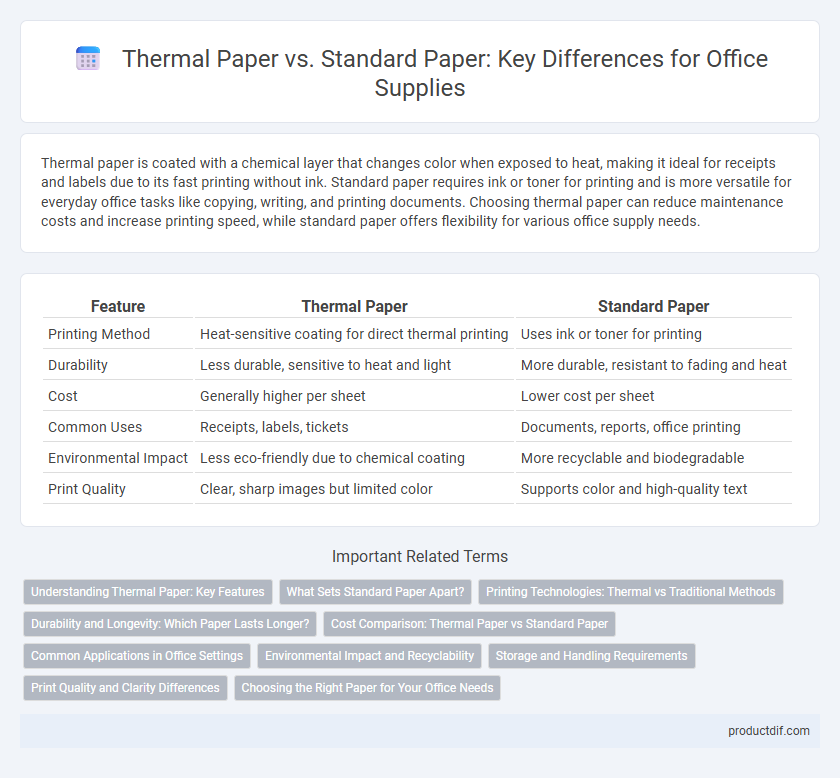Thermal paper is coated with a chemical layer that changes color when exposed to heat, making it ideal for receipts and labels due to its fast printing without ink. Standard paper requires ink or toner for printing and is more versatile for everyday office tasks like copying, writing, and printing documents. Choosing thermal paper can reduce maintenance costs and increase printing speed, while standard paper offers flexibility for various office supply needs.
Table of Comparison
| Feature | Thermal Paper | Standard Paper |
|---|---|---|
| Printing Method | Heat-sensitive coating for direct thermal printing | Uses ink or toner for printing |
| Durability | Less durable, sensitive to heat and light | More durable, resistant to fading and heat |
| Cost | Generally higher per sheet | Lower cost per sheet |
| Common Uses | Receipts, labels, tickets | Documents, reports, office printing |
| Environmental Impact | Less eco-friendly due to chemical coating | More recyclable and biodegradable |
| Print Quality | Clear, sharp images but limited color | Supports color and high-quality text |
Understanding Thermal Paper: Key Features
Thermal paper, coated with heat-sensitive chemicals, enables printing through thermal transfer without ink or toner, making it ideal for receipts and labels. Its smooth surface enhances print clarity and durability, resisting fading and smudging under normal conditions. Compared to standard paper, thermal paper offers quicker, quieter printing and reduces maintenance costs by eliminating ink cartridges.
What Sets Standard Paper Apart?
Standard paper offers greater versatility than thermal paper, supporting various printing methods such as inkjet, laser, and offset printing. It usually provides better durability for archival purposes, making it ideal for documents that require long-term preservation. The ability to handle a wider range of inks and finishes distinguishes standard paper as the preferred choice for general office use and professional printing.
Printing Technologies: Thermal vs Traditional Methods
Thermal paper is specially coated to react to heat, enabling direct thermal printers to produce images without ink or toner, which streamlines printing processes and reduces operational costs. In contrast, standard paper requires traditional printing methods such as inkjet or laser printers that rely on liquid or powder-based inks and toners for image formation. Thermal printing technology offers faster print speeds and less maintenance, making it ideal for receipts, labels, and tickets, whereas traditional printing ensures higher color fidelity and versatility for varied office documents.
Durability and Longevity: Which Paper Lasts Longer?
Thermal paper is coated with a heat-sensitive layer that darkens when exposed to heat, but it tends to fade over time, especially when exposed to light or heat, reducing its longevity compared to standard paper. Standard paper, often used with ink or toner, generally offers better durability and resistance to environmental factors, making it a more reliable choice for long-term document storage. For office supplies requiring lasting records, standard paper is preferred due to its superior archival qualities.
Cost Comparison: Thermal Paper vs Standard Paper
Thermal paper generally costs more upfront than standard paper due to its specialized heat-sensitive coating required for thermal printers. However, thermal paper eliminates the need for ink or ribbon cartridges, reducing ongoing expenses and maintenance costs associated with standard paper printing. Over time, businesses experience lower overall costs with thermal paper despite the higher initial investment, especially in high-volume printing environments.
Common Applications in Office Settings
Thermal paper is commonly used for receipts, shipping labels, and fax machines in office settings due to its heat-sensitive coating that produces fast, clear prints without ink. Standard paper is preferred for everyday printing, photocopying, and document drafting, offering versatility and compatibility with various office printers and copiers. Offices often choose thermal paper for tasks requiring quick, smudge-free output, while standard paper remains essential for formal reports and correspondence.
Environmental Impact and Recyclability
Thermal paper contains a heat-sensitive coating that often includes chemicals like BPA or BPS, making it less environmentally friendly compared to standard paper, which is typically easier to recycle and free from harmful coatings. Standard paper's higher recyclability reduces waste in landfills, whereas thermal paper's chemical layers hinder the recycling process, often requiring specialized disposal methods. Offices aiming to minimize environmental impact should prioritize using standard paper over thermal paper where possible to support sustainable waste management practices.
Storage and Handling Requirements
Thermal paper requires storage in a cool, dry environment to prevent discoloration and loss of print quality due to heat and humidity exposure. In contrast, standard paper is less sensitive but should still be kept away from moisture and direct sunlight to maintain durability. Proper handling of thermal rolls includes avoiding excessive pressure and fingerprints, which can affect image clarity, unlike standard paper that withstands typical office handling.
Print Quality and Clarity Differences
Thermal paper delivers sharper print quality with precise, clear images and text due to its heat-sensitive coating, making it ideal for receipts and labels requiring high-resolution detail. Standard paper relies on ink or toner, which can result in slight smudging or fading over time, affecting print clarity, especially in documents needing long-term legibility. Businesses prioritize thermal paper for crisp, smudge-resistant prints, while standard paper suits general office needs where ink durability and cost-efficiency are key.
Choosing the Right Paper for Your Office Needs
Thermal paper offers quick, high-quality printouts ideal for receipts and labels, while standard paper provides versatility for printing documents and general office use. Selecting the right paper depends on your office's specific requirements, such as print type, durability, and cost-efficiency. Evaluate factors like printer compatibility, print volume, and intended application to optimize office productivity and minimize expenses.
Thermal Paper vs Standard Paper Infographic

 productdif.com
productdif.com